Study and Analysis of a Root Cause of Failure
in Resin Composite Materials
Deterioration in Adhesiveness of Resin/Composite Materials
In-page menu
JFE-TEC investigates the causes of defects related to polymeric resins used in various products to solve the defects.
Investigation of the Adhesion and Peeling Mechanisms of Polymeric Resins - Its Necessity and Outline -
Polymeric resins are used in a broad range of fields such as aircraft, automobiles and electronics in various forms such as adhesion between metal and resin and between resin and rubber and film lamination to metal, and defects of adhesives such as peeling have been on the increase.
JFE-TEC has been working on the clarification of the peeling mechanism of polymeric adhesives by making the most of our analysis techniques such as morphological analysis of adhesive state, chemical structure analysis of cured material, thermal analysis and mechanical characteristic analysis.
In addition, we provide support for your activities from model experiment to durability evaluation test for mechanism clarification at your request in order to prevent peeling or develop a new adhesive.
Items of Investigation/Analysis
-
- Morphological analysis of adhesive state (CCD, SEM/EDX, etc.)
- Chemical structure analysis of the bonded part (FT/IR, etc.)
- Thermal analysis of the bonded part (DSC, TG, etc.)
-
- Solvent immersion test of the bonded part (degree of swelling, gelation rate, etc.)
- Mechanical characteristics of the bonded part (tension test, peeling test)
- Non-destructive inspection of the bonded material (X-ray transmission observation)
-
- Wettability evaluation through measurement of the surface free energy
- Investigation of the curing behavior of an adhesive based on rigid pendulum test
- Investigation of the peeling interface through combined use of fluorescent X-ray and XPS
Case Examples of Peeling Mechanism Investigation
Fracture of adhesion systems is divided into three patterns: interfacial peeling where fracture occurs at the interface between the adhesive and the adherent, interlaminar fracture where fracture occurs at the adhesion layer, and material fracture where the adherent is fractured. By conducting morphological analysis of the fracture surface, the pattern in which the peeling occurred can be determined.
(1)For interfacial peeling, the initiating cause (unevenness in adhesion, oil, dust, bubble formation, etc.) can be clarified by conducting morphological analysis of the peeled surface.
(2)For interlaminar fracture, the cause leading to fracture (insufficient curing, material deterioration, etc.) can be clarified by sampling the cured material and conducting chemical structure analysis of the cured part, thermal analysis, solvent immersion test, etc.
-
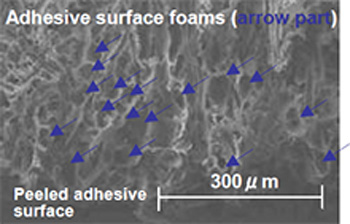
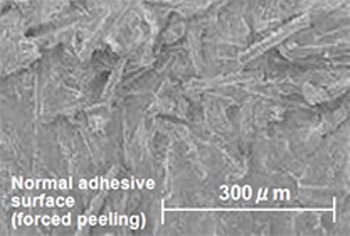
Examples of SEM image of the peeled surface (acrylic adhesive) -
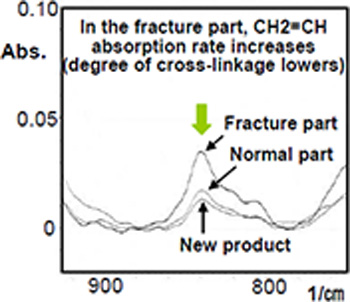
Example of evaluation based on FT-IR analysis (acrylic adhesive)
-
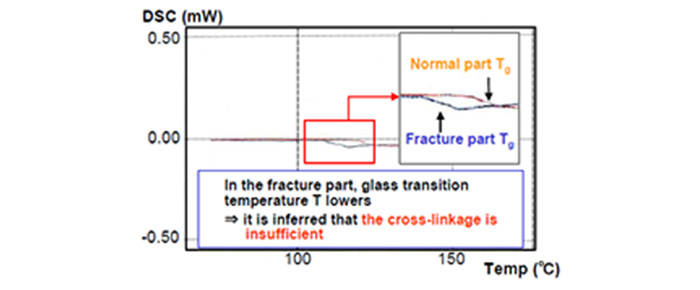
Example of evaluation based on DSC*1) analysis (epoxy adhesive)
*1)DSC = Differential Scanning Calorimetry -
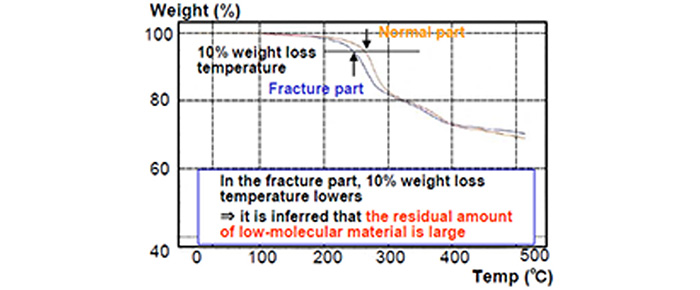
Example of evaluation based on TG*2) analysis (epoxy adhesive)
*2)TG = Thermo Gravimetry) -
Example of solvent immersion test of cured material Fracture part Normal part Degree of swelling (a) 135% 110% Gelation rate (b) 20% 80% Cross-linkage type(a) Epoxy adhesive
(b) Modified EVA-based adhesive filmIn the fracture part, cross-linkage is insufficient
-
⇒Non cross-linked part is affected by the solvent and the degree of swelling increases
⇒Gelatin rate decreases because the material is dissolved by the solvent


